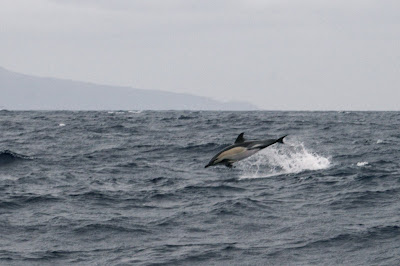 |
| Sao Jorge (photo from Wiki Commons) |
The Azores are unlike anywhere I have been before. Although the landscape is absolutely stunning, there is actually not much tourism on the islands that I have visited. I think one of the main reasons for this is because they don't have any beaches at all, (they are too young). This immediately puts off a lot of people!
The land rises up out of the sea in a dramatic way in most places I visited, and and the closest thing to a beach I saw was small, abrasive, volcanic boulders.
 |
| Santo Amaro |
 |
| Green, untouched woodland that covers a lot of the islands |
 |
| Volcanic coastal rock |
The Azores are famous for the marine life that lives in the surrounding waters. In fact, one of the biggest tourism draws to the islands is its diving and whale and dolphin watching boat trips. Unfortunately I haven't had time to do any diving (next time!) but I did get out on a boat for a morning when I had some time off!
 |
| Whale and dolphin spotting! |
Although as you can see from the sea state in the pictures it wasn't the nicest of days to go whale spotting (the weather is really changeable here) we did see loads of dolphins! Four different species in total that put on a display for us that lasted a few hours.
 |
| Common dolphin (Delphinus depphis) |
 |
| Striped dolphin (Stenella coeruleoalba) |
Ok that's enough dolphin photos.... we also saw spotted dolphins and risso's dolphins. Unfortunately because the sea wasn't that calm we didn't manage to spot any whales (you have to watch for the air being expelled from their blowholes). Gives me a good excuse to come back anyway :)
 |
| Old whaling boat and truck |
Sadly though, these awesome creatures that bring people to the islands every year were actually hunted by the islanders until the 1980s. The whaling industry supported the inhabitants of Pico, and around the island there are still lots of signs. There are a few whaling museums that have been set up in the old whaling stations that although are pretty upsetting, are definitely worth a visit for an education.
I have also climbed to the very top of Mount Pico, the highest point in Portugal, rising to an impressive 7713 ft above sea level. One thing I would definitely recommend is making sure you take suncream and enough water. The day I climbed it looked cloudy from the ground but you soon climb higher than that.... and I will have the tan lines to prove it for a while!
 |
| Mount Pico, on a rare clear day! |
 |
| Happy and burnt at the top! |
The town of Horta (where the University was), on Faial Island is an infamous stopover for sailors crossing the Atlantic, and is the home of Peters Cafe Sport Bar - famous for their gin and tonics and a the scrimshaw museum upstairs! On the bar there were loads of adverts for people wanting crew to help out on boats sailing back to the UK.... now if I didn't already have a plane ticket...
 |
| Graffiti on on the marina in Horta, Faial |
So that (unfortunately) brings me to the end of my Azorian adventure for now. As brief as it has been, I have definitely made the most of my time here.. and hopefully one day will come back. It has been great to get experience at the University out here, and I'm really excited about spending time in the lab back in the UK... who know's what we will find!
 |
| Sunset over Faial |
















